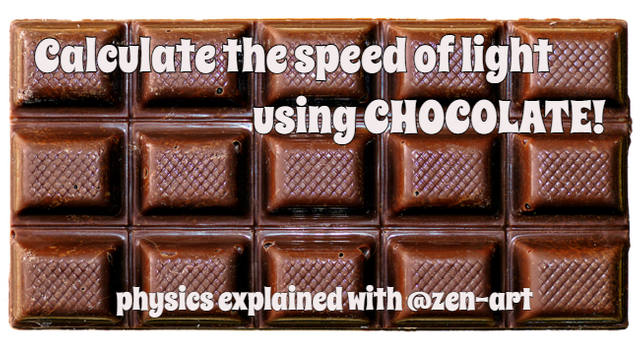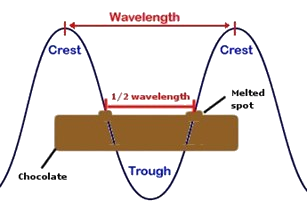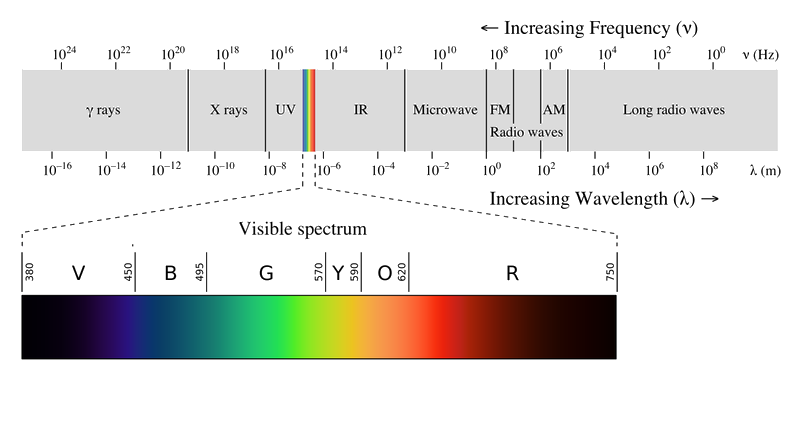Calculate the speed of light using CHOCOLATE - physics explained
Time for some fun science again! This time, with chocolate. Yes, it can be used for scientific purposes and not just for eating but we will eat our chocolate once we are done. It will be a treat to award ourselves after we finish our calculation. Are you ready for some physics fun? Let's go!

You have all probably heard of this great guy named Albert, right? Albert Einstein was one of the best minds in the area of physics. He made a connection between matter and energy, the famous formula E=mc2 (energy equals mass multiplied by the speed of light squared). I will leave this for some future post because I do intend to explain this formula to you, for now, it is here just to remind you of that c or the speed of light. This is probably the place you think c originates. Nope. No, it does not 😁
c is the speed of light and the maximum speed at which anything can travel in the universe.


Electromagnetic waves travel

So why did we use the microwave oven
You have calculated the speed of light



@steemitbloggers

We will try and calculate that speed in our little experiment but keep in mind that we will not get the exact result because of the uncertainty in our measurements but we will get pretty close.
- one microwave oven
- a plate (safe to use in a microwave oven)
- a piece of paper and a pencil for our calculations
- one bar of chocolate
- a ruler
- a calculator
You can use any chocolate you want but try to use the one that you like because you will be eating it later on as a prize for your work well done. Chocolate will go into the microwave so do not use a bar that is too big. A plain, normal sized chocolate will do the job.
The first thing you have to do is remove the rotating plate from the microwave and place a normal plate inside. Just be careful that the plate you are putting in there is safe to use. It should not have any metal or metal colors on it or be from cheap, easy melting plastic.
Find a sticker on your microwave (it is usually at the back) that has information on it. Read and copy the microwave frequency to your piece of paper. It is shown in MHz and usually higher than 2000 for standard microwaves. Multiply that number with 1000 to get Hz and note that it is the FREQUENCY. You will need it in our calculations later.
We have our first data. THE FREQUENCY. (Hz units)
Put your chocolate bar on the plate and close the microwave door. Set the timer for 30 seconds and turn the microwave on. When the time runs out, open the door and carefully remove the plate from the microwave. It will be hot so use gloves or something to protect yourself from the heat.
You will notice that your chocolate bar is not melted equally in all its places. There is a melted place following the unmelted and so on. Take your ruler and measure the distance between two melted places. Your ruler is probably in centimeters. Multiply the centimeters measured with 0,01 to get the meters and write that down on your paper as the λ/2. Multiply it by 2 to get the wavlenght λ
We have our second data. THE WAVELENGHT. (m units)
WHAT HAPPENED?
Microwave ovens heat our food using standing waves. They are formed when a wave is reflected back and forth between surfaces n/2 wavelengths apart (n is any positive whole number). Nodes and antinodes are always at the same place and that is why there is a rotating plate inside. If it were not, the food would not heat up evenly.
Places, where food would remain cold are static nodes. The amplitude of the electromagnetic wave is zero at those nodes. Places, where that amplitude has maximum or minimal values are called antinodes and food gets heated up in those. When the food is rotated on a plate, different parts of it come to antinode places and heat up.
In our experiment, we removed that rotating plate and switched it with a normal one. Since our chocolate was not rotating, it melted in specific places, the antinode places.

Now all we have to do is calculate the speed of light. Easy, right? Yes, it is. Math time!
Electromagnetic waves are those that have oscillating magnetic and electric fields. In waves you can see in any material (wave, rope, etc.) there are particles that are vibrating up and down and when we look at the whole material it has a wave shape. There are no particles vibrating in electromagnetic waves. EM waves do not need a medium to propagate, instead, electric and magnetic vector fields are interchanging. They are perpendicular to each other and to the direction of the wave.
Electromagnetic waves travel
at a constant speed.
The speed of electromagnetic waves in vacuum is constant and is 3*10^8 m/s^2. Does that number sound familiar? It is the speed of light that we mentioned at the beggining of this post. Light is an electromagnetic wave, and so are microwaves.
Based on their wavelength, electromagnetic waves are classified as radio, microwave, infrared, visible, ultraviolet, X-rays and gamma rays. Visible light is only a small part of the scale. We can not see the microwaves that are in the microwave oven but we can use them and measure their effects.

So why did we use the microwave oven
in this experiment?
We used the microwave oven because microwaves are electromagnetic waves, just as the light is and as microwaves are, they have a constant speed. By calculating their speed we are actually calculating the speed of light because those two speeds are the same.
CAN WE CALCULATE IT ALREADY?
Fine. We can calculate it. I think I have been explaining enough and I can understand how you are eager to do the math.
Wave speed can be calculated in two ways. The speed of the wave is defined as the distance that a wave travels in a certain amount of time. We can, therefore, divide the distance that a wave has traveled in meters with the time spent in seconds. This is of no use for us here because we have neither. What we do have are frequency and wavalenght and luckily for us, that is all we need.
Speed = Wavelength x Wave Frequency
This formula is valid for all waves, including the electromagnetic ones. All we have to do is multiply the frequency (in Hz), that we found on the back of the microwave oven, with the wavelength that we measured. The result will be the speed of light. Well... Not really the speed of light because our measuring was not precise enough, but close enough!
You have calculated the speed of light
USING CHOCOLATE!

You can eat it now 😁
If you do not like chocolate, you can use marshmallows. There is a detailed explanation with images and calculation here:
SPEED OF LIGHT IN A MICROWAVE (WITH MARSHMALLOWS!)
To learn more or just to check my sources follow these links:
Measure the speed of light using chocolate - planet science
Wave Speed - CK12
Learn How a Microwave Works in Agonizing Detail in Under Five Minutes
What Are Microwaves? - live science
Image sources:
- chocolate image is under CC0 license and is free for private and commercial use, you can check the person who made it by visiting his pixabay profile here: anaterate
- microwave with nodes and anitnodes image source
- wavelength on chocolate image source
- EM spectrum source
For my recent Philosophy of hapiness posts follow these links:
- There is nothing positive in being negative
- What is the difference between fault and responsibility?
- Are you carrying prejudices?
- Thank your parents, they did the best they could
- Where attention GOES, energy FLOWS
- How to decipher your DREAMS
- Panic attacks - a heart-attack monsters
For the "Into the quantum world..." novel that I am writing exclusively for steemit click here:
For my DIY and craft posts visit these links:
- My sewn toys - felt craft-work, which one is your favorite?
- Make yourown wooden counter! - DIY tutorial
- Make your own gnome - tutorial(ish)


@steemitbloggers




Now I wish I had a microwave to try this out with the kids...
Really cool...😊
Try explaining it to them at least, maybe your story about it will be interesting to them just as the experiment would be 💚
I sent the link to my lot, and next time we are at MIL's, we will try it out..
Thanks @zen-art
Hahah amazing as your every post!
Thank you :)
So great!
That's the way to make physics interesting. I really hope I inspired you to write it with my "heat your house using cats" :D
I second your research and that's a nice way to end a busy week. Thanks!
Hihihi, those cats of yours were hilarious and educational at the same time. I love when science is like that. Thank you for stopping by fellow science lover 💚
Your article was sitting top level on my feed and it was 3 minutes old :D
It was asking for curation :D
Have a wonderful weekend!
You too 💚
Ahahahahaha. Great article. That might be the best explanation of wave nodes that I've ever seen and I've actually seen a couple.
I'm on a strict diet so can't use chocolate or marshmallows but it's OK. Speed of light is one of those numbers that I carry around in my head. Some of the better baggage that I've picked up over the years I suppose.
Thank you for a wonderful article. I just love seeing stuff like this.
Wow, best explanation? Now I feel proud of myself :) Thank you for your kind words, I am glad you like what I wrote 💚
You have been upvoted by the @sndbox-alpha! Our curation team is currently formed by @jeffbernst, @bitrocker2020, @jrswab & @teachblogger . We are seeking posts of the highest quality and we deem your endeavour as one of them. If you want to get to know more, feel free to check our blog.
Thank you 💚💚💚
I don't have any chocolate to hand, but that is a really interesting and clearly-illustrated demonstration of how microwave ovens work! The electromagnetic spectrum is just fascinating.
Actually it's a good excuse to go and buy some chocolate :)
Like you needed an excuse to buy chocolate LOL, chocolate is self-explanatory and always good to have around :D
Haha! Yup.
This was a great post and a great experiment. I had never thought to combine two such awesome things into one post. Chocolate and physics, both totally awesome! I might have to keep this post handy to share with my nieces and nephews when they are old enough to understand some of it. :)
It is pretty interesting to kids in high school. Wait and remember it :)
Thanks!
Lol, that's one way to use chocolate!
One of many ;)
Wow, this is an awesome experiment!! Almost makes me wish we had a microwave, haha. I may need to borrow a friend's and try it out!
This is what you do:
Then lean back and let loose the evillest evil laugh ever and watch them cry!
Bwah Hahahahahahaha~!
Perfect plan! >:D
Amazing post.... Didn't know the speed of light could be calculated using chocolate, I'll certainly try this one day and I'll make a post about it.... I won't forget to mention you or post a link in the comment section... I just hope the result will be close to the value of the speed of light...
Excellent post..!!
I am looking forward to reading that post and I am sure you will do the calculation correctly. Good luck.